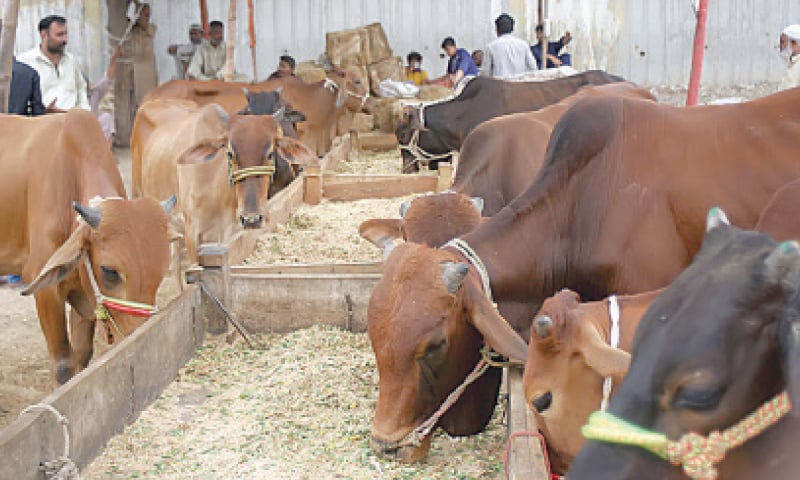In Punjab, people have credible data on the livestock population. In other provinces, they don’t. The reason is that the Punjab government released in 2017-18 the results of its 2016 census of livestock based on physical surveys. The other three provinces have yet to follow suit.
The authors of the Pakistan Economic Survey are thus incapable of reporting national-level, actual livestock numbers. They present estimates every year based on the growth rate of the animal population recorded in the 2006 census over the 1996 census. The last livestock survey was conducted in 2006 across Pakistan. But that was a sample survey. Using an old inter-census growth rate for estimating the livestock population keeps policymakers in the dark. It also makes it difficult to assess how the slaughtering of cows, calves, bulls, buffaloes, goats, sheep and camels every Baqra Eid is affecting their countrywide population.
The Pakistan Tanners Association (PTA) releases the number of hides and skins of sacrificial animals every year after the three-day religious event is over.
Conducting an animal census across Pakistan and making a realistic assessment of large-scale sales of sacrificial animals on Baqra Eid are important for food security
Tanneries get supplies through a network of dealers and agents, seminaries, NGOs, political parties and social groups involved in the collective sacrifice of animals.
The PTA number serves as a proxy for the number of animals sacrificed. But a flawed system of hide collection, inaccurate reporting and deliberate under-reporting reduce the credibility of the PTA number. Also, this number appears small when we apply other proxies. These proxies include the number of sacrificial animals sold in major markets, amount of additional home remittances ahead of Baqra Eid and sales reported by online animal sellers etc.
So there is a need to obtain actual data on the sales of sacrificial animals on this occasion to collect applicable taxes as well as help evaluate the size of the Baqra Eid economy. This is a complex task and cannot be fulfilled without effective coordination among federal, provincial and local governments and relevant departments and agencies. Obtaining a closer-to-reality estimate of the size of the Baqra Eid economy is crucial for more informed future estimates of consumption, movement of funds and the informal economy. Till the time we get the results of a nation-wide animal census, more reliable estimates of sales of sacrificial animals will help us understand the effects of Baqra Eid on the livestock economy.
After last year’s Baqra Eid, tanneries reported the arrival of up to 8.01 million hides and skins of sacrificial animals. That included 5m skins of goats and sheep, 3m hides of cows, calves, bulls and buffaloes and about 100,000 hides of camels.
According to the federal government’s estimates, a total of 90m hides and skins were collected last year. This means that Baqra Eid-specific slaughtering of sacrificial animals accounts for about 9pc of routine slaughtering in a year. This is a big number even if we overlook the flaws in data collection and reporting.
The country’s economy is under stress, joblessness is high and the income level is lower than a year ago. Inflation is soaring. So the sales of sacrificial animals this year cannot be expected to exceed the last year’s level. But even if the nation slaughters the same number of animals this year (8.01m), it will constitute more or less the same share (9pc) in the entire year’s routine slaughtering of animals for meat supplies and exports.
Shouldn’t the economy of an event that accounts for 9pc of the total animal slaughtering in a country be documented properly?
According to the federal government’s statistics, populations of cattle, buffalo, goats and sheep have been on the rise. But the application of inter-census growth rates for estimating the population of livestock can be misleading at times. For example, the national population of cattle, buffaloes, goats and sheep estimated with this formula showed a handsome increase even in 2010-11. Officials concerned had obviously not factored in the direct and indirect effects of the super floods in August and September of 2010 on the livestock.
When Punjab began the census of domestic animals in 2016, its initial results showed that the actual provincial livestock were far less than what the federal government had reported previously. The culprit was the use of the inter-census growth rate.
Conducting an animal census across Pakistan and making a realistic assessment of large-scale sales of sacrificial animals on Baqra Eid are important for food security and efficient crop management as well. Raising livestock on local fodder crops consumes a large area of land part of which can be spared for import-substituting crops.
Since policymakers don’t know the actual population of livestock across Pakistan, they cannot make well-informed decisions about how much land should suffice for growing fodder crops.
Similarly, in the absence of credible data on the sales of sacrificial animals, they cannot make realistic projections about the specific needs for fodder in different cities and towns during Baqra Eid. Consequently, prices of animal food shoot up and supplies remain erratic. —MA
Published in Dawn, The Business and Finance Weekly, August 19th, 2019















































Dear visitor, the comments section is undergoing an overhaul and will return soon.